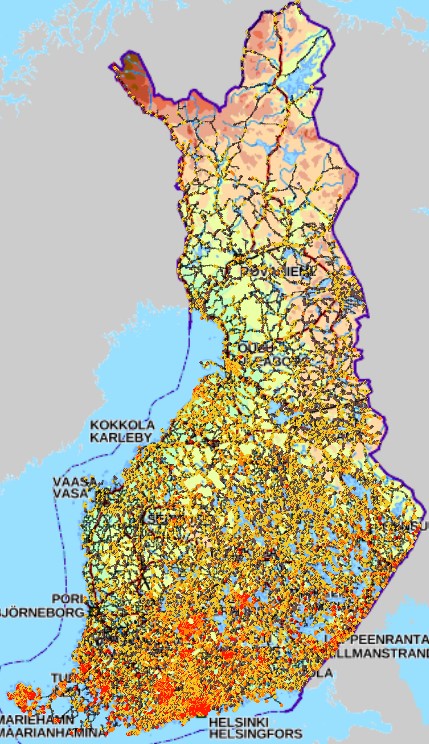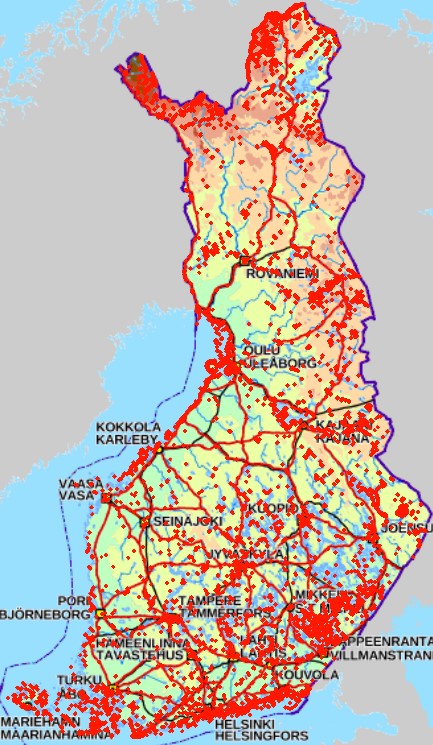dataset
Type of resources
Available actions
Topics
Keywords
Contact for the resource
Provided by
Years
Formats
Representation types
Update frequencies
status
Service types
Scale
Resolution
-

FIN Aineiston tarkoituksena on: -Identifioida tie- ja rata-alueet, joiden varrella esiintyy uhanalaisia ja silmälläpidettäviä lajeja -Identifioida tie- ja rata-alueet, joiden varrella esiintyy hyviä elinvoimaisia niittyindikaattorilajeja (hyönteisten mesi- ja ravintokasveja) -Identifioida tie- ja rata-alueet, joiden varrella esiintyy suojelualueita -Identifioida tie- ja rata-alueet, joiden varrella esiintyy komealupiinia tai kurtturuusua -Identifioida tie- ja rata-alueet, joiden varrella esiintyy komealupiinia tai kurtturuusua uhanalaisten lajien lisäksi -> Löytää herkät alueet ja paikallistaa vieraslajien uhka Tieto esitetään 1 kilometrin ruuduissa. Aineistosta on julkaistu kaksi erillistä versiota. -VaylanvarsienVieraslajitJaArvokkaatElinymparistot_avoin: Avoin versio, jonka lajitietoa on karkeistettu mahdollisista herkistä lajeista johtuen. Aineisto kuuluu SYKEn avoimiin aineistoihin (CC BY 4.0) ja sitä saa käyttää lisenssiehtojen mukaisesti -VaylanvarsienVieraslajitJaArvokkaatElinymparistot_kayttorajoitettu: Alkuperäinen karkeistamaton versio. Tämä versio on vain viranomaiskäyttöön eikä kyseistä aineistoa saa jakaa Aineistosta on tehty tarkempi menetelmäkuvaus https://geoportal.ymparisto.fi/meta/julkinen/dokumentit/VierasVayla_Menetelmakuvaus.pdf sekä muuttujaseloste https://geoportal.ymparisto.fi/meta/julkinen/dokumentit/VierasVayla_VariableDescription.xlsx ENG The purpose of the material is to: -Identify road and rail areas that have nearby observations of endangered and near threatened species -Identify road and rail areas with good meadow indicator plant species -Identify road and rail areas along which there are protected areas -Identify the road and rail areas along which there are observations of Lupinus polyphyllus or Rosa rugosa observations -Identify the road and rail areas along which there are Lupinus polyphyllus or Rosa rugosa observations in addition to sensitive species -> Finds sensitive areas and identify the overall threat of alien species The data is presented in 1-kilometer square grid cells. There are two separate versions of the data. -VaylanvarsienVieraslajitJaArvokkaatElinymparistot_avoin: Open access version, in which its species-related parts have been simplified due to data restriction issues. The material belongs to Syke's open materials (CC BY 4.0) and may be used in accordance with the license terms. -VaylanvarsienVieraslajitJaArvokkaatElinymparistot_kayttorajoitettu: Original version. This version is only for official use and the material in question may not be shared. A more precise description about the data procedures can be found from (In Finnish) https://geoportal.ymparisto.fi/meta/julkinen/dokumentit/VierasVayla_Menetelmakuvaus.pdf Furthermore, all the variables in the data are explained in this bilingual variable description https://geoportal.ymparisto.fi/meta/julkinen/dokumentit/VierasVayla_VariableDescription.xlsx This dataset was updated with the newest species observations on 10/2023 and 11/2024 Process code for this can be found from https://github.com/PossibleSolutions/VierasVayla_SpeciesUpdate
-

FIN Suomen hiekkarantoja ja niiden taustatekijöitä kuvaava aineisto. Datan taustalla olevan hankkeen pääasiallisena tarkoituksena on hiekkarantojen identifioiminen parhaasta käytettävissä olevasta tiedosta, näiden rantojen ominaispiirteiden kuvaaminen, ympäristöllisen arvon arvioiminen sekä hoitotarpeessa olevien rantojen löytäminen. Aineistosta on julkaistu kaksi erillistä versiota. -HiekkarantojenOminaisuudet_avoin: Avoin versio, jonka lajitietoa on karkeistettu mahdollisista herkistä lajeista johtuen. Aineisto kuuluu SYKEn avoimiin aineistoihin (CC BY 4.0) ja sitä saa käyttää lisenssiehtojen mukaisesti -HiekkarantojenOminaisuudet_kayttorajoitettu: Alkuperäinen karkeistamaton versio. Tämä versio on vain viranomaiskäyttöön eikä kyseistä aineistoa saa jakaa” Aineistosta on tehty tarkempi menetelmäkuvaus https://geoportal.ymparisto.fi/meta/julkinen/dokumentit/RantaPutte_Menetelmakuvaus.pdf sekä muuttujaseloste https://geoportal.ymparisto.fi/meta/julkinen/dokumentit/RantaPutte_VariableDescription.xlsx ENG This data describes Finnish sandy beaches and their background factors. The main purpose of the project underlying the data is to identify sandy beaches from the best available information, to describe the characteristics of these beaches, to assess their environmental value and to find beaches in need of conservation There are two separate versions of the data. -HiekkarantojenOminaisuudet_avoin: Open access version, in which its species-related parts have been simplified due to data restriction issues. The material belongs to Syke's open materials (CC BY 4.0) and may be used in accordance with the license terms. -HiekkarantojenOminaisuudet_kayttorajoitettu: Original version. This version is only for official use and the material in question may not be shared. A more precise description about the data procedures can be found from (In Finnish) https://geoportal.ymparisto.fi/meta/julkinen/dokumentit/RantaPutte_Menetelmakuvaus.pdf All the variables in the data are explained in this bilingual variable description https://geoportal.ymparisto.fi/meta/julkinen/dokumentit/RantaPutte_VariableDescription.xlsx
-
KUVAUS: Jätehuoltomääräysten biojätteen velvoitealue. Tampereen keskustaajaman alue esitetään kartalla keltaisella. Tampereen keskustaajamassa velvoite on ollut voimassa 1.9.2023 alkaen. Biojätteen velvoitealueen laajennusalueet esitetään kartalla sinisellä. Laajennusalueiden velvoite tulee voimaan siirtymäajan jälkeen, 30.9.2025 mennessä. PÄIVITYS: Satunnainen (vain tarvittaessa). YLLÄPITOSOVELLUS: Tampereen kaupungin tiedostopalvelin ja PostGIS-tietokanta KOORDINAATTIJÄRJESTELMÄ: Aineisto tallennetaan ETRS-GK24FIN (EPSG:3878) tasokoordinaattijärjestelmässä GEOMETRIA: vektori (alue) SAATAVUUS: Aineisto on tallennettu Postgis-tietokantaan. JULKISUUS: Aineisto on nähtävillä julkisesti kaikille käyttäjille Oskari-karttapalvelussa. TIETOSUOJA: Aineistoon ei liity tietosuojakysymyksiä. AINEISTOSTA VASTAAVA TAHO: Tampereen kaupunki, Alueellinen jätehuoltolautakunta, jatehuoltolautakunta@tampere.fi
-

The Regional Till Geochemical Mapping data set gives information on the concentrations of 37 elements in unaltered basal till. The samples have been taken, in 1983, from an unaltered basal till (C horizon) below the groundwater table at a depth of ca. 70 cm (variation 50-200 cm) with a density of one sample per 300 km2. The data set covers the whole of Finland with a total sample amount of 1056. The samples are composite field samples. The calculated sample point coordinates entered in the data set have been obtained from the centroid coordinates of five subsamples. The subsamples have been collected from a 300 m x 1000 m rectangular-shaped area. In Northern Finland, samples have been obtained by including samples taken previously in the Nordkallot Project. The samples have been sieved for analysis at a grain size grade less than 0.06 mm. The samples have been analysed for total elemental concentrations and aqua regia concentrations. Total concentrations have been determined either by neutron activation analysis (method code 900N) or by total dissolution with strong concentrated mineral acids (method code 312P). The analysis code for aqua regia dissolution is 511P. Gold and palladium have been determined with a analysis method based on flameless atomic absorption (519U). The sulfur concentration has been determined with a LECO analyser (810L). Further, total concentrations (312P) and aqua regia soluble concentrations (511P) were determined from Southern Finland and Mid-Finland samples with a grain size grade less than two millimetres. The original purpose of the Regional Till Geochemical Mapping data set was national geochemical general mapping and ore exploration. Other uses are, for example, estimating the baseline concentration of the soil, the nutrient levels of forest soil, assessing the buffering capacity of base cations in the soil and evaluating the weathering rate.
-
The data includes traffic volumes in Finland from 2012 to 2023. Data contains traffic volumes of all traffic and truck traffic.
-
FTIA INSPIRE Transport Networks Theme Dataset is a dataset depicting the Transport Networks covering the whole of Finland. It contains the following INSPIRE feature types: Road network, Rail network, Waterway network and Air transport network. The dataset is available via the FTIA INSPIRE Download Service (WFS) for Transport Networks and it can be viewed via the FTIA INSPIRE View Service (WMS) for Transport Networks.
-
This dataset contains points of information describing the location and size of spills of mineral oil observed during aerial surveillance flights by HELCOM Contracting Parties during 1998-2023. The data covers detections from fixed-wing aircraft only. Since 2014 Contracting Parties have also reported spills of other substances and unknown substances. The purpose of the regional aerial surveillance is to detect spills of oil and other harmful substances and thus prevent violations of the existing regulations on prevention of pollution from ships. Such illegal spills are a form of pollution which threatens the marine environment of the Baltic Sea area. Further information on detected spills in the Baltic Sea area and HELCOM aerial surveillance activities can be found at http://www.helcom.fi/baltic-sea-trends/maritime/illegal-spills/ and https://helcom.fi/action-areas/response-to-spills/aerial-surveillance/ The dataset contains the following information: Country Year Spill_ID = A unique code which will enable each individual spill to be individually identified FlightType = The type of flight the detection was made during: National = "N", CEPCO = "C", Super CEPCO = "SC", Tour d’Horizon = “TDH” Date = The date of the detection (dd.mm.yyyy) Time_UTC = The time of the detection in UTC (hh:mm) Wind_speed = The wind speed at the time of the detection (m/s) Wind_direc = The wind direction in degrees at the time of the detection (degrees) Latitude = The latitude of the detection (decimal degrees, WGS84) Longitude = The longitude of the detection (decimal degrees, WGS84) Length__km = The length of the detection (km) Width__km = The width of the detection (km) Area__km2_ = The area of the detection (km2) Spill_cat = Spill/pollution category: Mineral Oil = “Oil", Other Substance = "Other substance" , "Unknown substance" = “Unknown” EstimVol_m = If Spill_cat="Oil", then estimated min. volume of oil spill. Volume of the detection confirmed/observed as mineral oil as calculated using the Bonn Agreement Oil Appearance Code using the lower figure (BAOAC minimum) in m3. Vol_Category = Category of the detection: <0,1m3 = “1”, <0,1-1m3 = “2”, 1-10 m3 = “3”, 10-100 m3 = “4”, >100 m3 = “5” Type_substance = If Spill_cat="Other substance" or "Unknown. Product name or type of OS or GAR substances that could be identified (in case of known polluter, or via visual identification - cf. BAOAC Atlas). - Examples for OS: vegetable oils (palm oil sun flower oil, soya oil etc.), fish oil, molasses, various chemicals (methanol, biodiesels/FAME, toluene, paraffines etc.); Examples of GAR: solid cargo residues (e.g. coal residues), plastics, fish nets, … OR "Unknown" (in case the type of substance could not be identified) Polluter = Type of polluter source: Offshore Installation = “Rig”, Vessel = “Ship”, Other Polluter or source (e.g. land based source) = “Other”, Unknown = “Unknwon” (in case of an “orphan” spill that cannot be linked to a polluter) Remarks = Any additional information to inform on particular situations Description of marine litter sightings
-
Sedimentation rates are part of EMODnet (European Marine Observation and Data network) Geology, Work Package 3 (WP3) Seabed substrate. The objective of WP3 is to compile all available seabed substrate information on a scale of 1:100 000 or finer from all European marine areas, and to update sedimentation rate data collected in the previous phases. WP3 has compiled and harmonized available information on the rate of sedimentation on the seafloor. The information on sedimentation rates for recent sediments is presented as point-source information. Estimations of modern sedimentation rates (centimetres/year) can be based e.g. on established historical records of anthropogenic radionuclides (e.g. 137Cs and 241Am), polychlorinated biphenyls (PCBs), lead (Pb) and stable lead isotope (206/207Pb ratios). Sedimentation rate estimations can be based also on varve/laminae counting, radionuclide 210Pb and 14C decay dating methods. In addition stratigraphic marker horizons, like in the Baltic Sea, horizons formed by documented Major Baltic Inflow (MBIs) events (Moros et al. 2017), can be used in the estimations. Project partners have delivered information on sedimentation rates available in their national waters including their EEZ. The focus is on the present-day sedimentation rates. That means sediment accumulation to the seabed over the past decades, since AD 1900 or so. Further information about the EMODnet-Geology project is available on the portal (http://www.emodnet-geology.eu/).
-
This dataset represents the Integrated biodiversity status assessment for fish used in State of the Baltic Sea – Second HELCOM holistic assessment 2011-2016. Status is shown in five categories based on the integrated assessment scores obtained in the BEAT tool. Biological Quality ratios (BQR) above 0.6 correspond to good status. The assessment is based on core indicators of coastal fish in coastal areas, and on internationally assessed commercial fish in the open sea. The open sea assessment includes fishing mortality and spawning stock biomass as an average over 2011–2016. Open sea results are given by ICES subdivisions, and are not shown where they overlap with coastal areas. Coastal areas results are given in HELCOM Assessment unit Scale 3 (Division of the Baltic Sea into 17 sub-basins and further division into coastal and off-shore areas) Attribute information: "COUNTRY" = name of the country / opensea "Name" = Name of the coastal assessment unit, scale 3 (empty for ICES open sea units) "HELCOM_ID" = ID of the HELCOM scale 3 assessment unit (empty for ICES open sea units) "EcoystemC" = Ecosystem component analyzed "BQR" = Biological Quality Ratio "Conf" = Confidence (0-1, higher values mean higher confidence) "Total_indi" = Number of HELCOM core indicators included (coastal assessment units) "F__of_area = % of area assessed "D1C2" = MSFD descriptor 1 criteria 2 "Number_of" = Number of open sea species included "Confidence" = Confidence of the assessment "BQR_Demer" = Demersal Biological Quality Ratio "F_spec_Deme" = Number of demersal species included "Conf_Demer" = Confidence for demersal species "BQR_Pelagi" = Pelagic Biological Quality Ratio "F_specPela" = Number of pelagic species included "Conf_Pelag" = Confidence for pelagic species "ICES_SD" = ICES Subdivision number "STATUS" = Integrated status category (0-0.2 = not good (lowest score), 0.2-0.4 = not good (lower score), 0.4-0.6 = not good (low score), 0.6-0.8 = good (high score, 0.8-1.0 = good (highest score))
-
KUVAUS: Karttatason kohteet ovat peräisin Avoimet viheralueet Fiilis-karttakyselystä (viheralueet ja hulevedet yksikkö). KATTAVUUS: Tampere POIKKILEIKKAUS: Aineistoa ei ylläpidetä. KOORDINAATTIJÄRJESTELMÄ: Aineisto tallennetaan ETRS-GK24 (EPSG:3878) tasokoordinaattijärjestelmässä. GEOMETRIA: vektori (piste). SAATAVUUS: Aineisto on katsottavissa kirjautuneille käyttäjille Oskari-karttapalvelussa. AINEISTOSTA VASTAAVA TAHO: Tampereen kaupunki, Viheralueet ja hulevedet yksikkö
 Paikkatietohakemisto
Paikkatietohakemisto